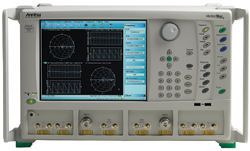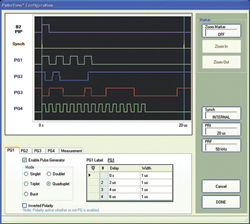
Traditional de-embedding techniques are oftentimes insufficient for today’s high-speed component designs utilized in high data rate applications. As frequencies approach 70 or even 110 GHz, errors related to fixturing can mask the behavior of the device under test (DUT). Poor de-embedding can lead to both passivity and causality errors. In addition, high fixture loss may affect the accuracy and repeatability of de-embedding. Anritsu Co. has developed enhancements to its VectorStar™MS4640B vector network analyzers (VNA) that make embedding/de-embedding straightforward and simpler, enabling users to obtain more accurate measurements of their DUT’s performance.
The new de-embedding capabilities of VectorStar VNAs can be used to remove test fixture contributions, modeled networks and other networks described by S-parameters (S2P files) from the measurement results for greater accuracy and repeatability. Similarly, the enhanced embedding function can simulate matching circuits to optimize DUT performance, which is very helpful in applications like amplifier design. The function can also be used to add effects of a known structure to a measurement. With the new capabilities, engineers have a greater ability to locate design weaknesses such as discontinuities, impedance changes and crosstalk issues in high-speed DUTs.
As an example, VectorStar users can combine a wide range of calibration capabilities with up to seven de-embedding techniques to address the various situations found in many high-frequency component designs. By matching the calibration and de-embedding method to specific DUT and fixture structures, measurement accuracy and repeatability are improved. In addition, unlike other VNAs that require external software to de-embed differential devices, VectorStar includes four-port differential de-embedding as part of the package of techniques for fast and accurate differential device analysis.
Better Device Modeling
With the enhanced embedding/de-embedding capabilities, better device modeling data can be acquired, resulting in greater design confidence and fewer design turns. Other features of the VectorStar MS4640B support improved device models as well, specifically the broad frequency coverage from 70 kHz to 70/110/125/145 GHz in a single connection. The highly accurate low-end frequency coverage enabled by a hybrid bridge-coupler VNA architecture reduces the risk of DC extrapolation errors in device models. Additionally, the wide frequency coverage eliminates the time-consuming, error-prone, concatenation process across the RF, microwave and millimeter bands.
VectorStar users can also improve their device modeling by taking advantage of high data resolution of 100,000 points and 700 kHz frequency step size to provide highly accurate, highly resolved, low pass mode measurements. The high resolution provides the ability to zoom in on narrow band responses without re-calibrating as well. When calibration is needed, it can be performed with Precision AutoCal®, which combines one-button ease with higher accuracy than the traditional SOLT technique.

Figure 1 PulseView™ setup.
VectorStar offers a number of features for improved high-frequency component testing, such as two software applications which provide unique analysis capability. PulseViewTM (see Figure 1) allows DUTs to be tested and characterized under pulse conditions. The 2.5 ns resolution with 100 dB dynamic range of VectorStar, coupled with independent measurement gates, provides industry-leading insight into component behavior. The ultra-high resolution enables users to see performance perturbations not only within a pulse, but on the rising/trailing edges as well. With the 500 ms capture time, amplifiers can be measured under long pulse repetition interval conditions. The software also allows for pulse-to-pulse measurements to be conducted over an extended number of pulses. An additional IF digitizer option, as well as four internal pulse generators, are required to utilize the PulseView application.
DifferentialViewTM, together with an optional internal second source, provides the ability to evaluate differential amplifier designs under true mode stimulus (TMS) conditions. The VectorStar graphical user interface (GUI) allows engineers to change parameters and see the results immediately without switching screen displays thereby reducing setup errors and reducing test time.
A noise figure option is also available for component testing applications. The noise figure measurement is based on a cold source technique for improved accuracy. Various levels of match and fixture correction are available for additional measurement enhancement.
With enhanced embedding/de-embedding capabilities coupled with frequency coverage from 70 kHz to 70 GHz, highly accurate calibration techniques and select options, the VectorStar series of VNAs provides the performance necessary to address the challenges of high frequency component design.
Anritsu
Morgan Hill, Calif.
www.anritsu.com
